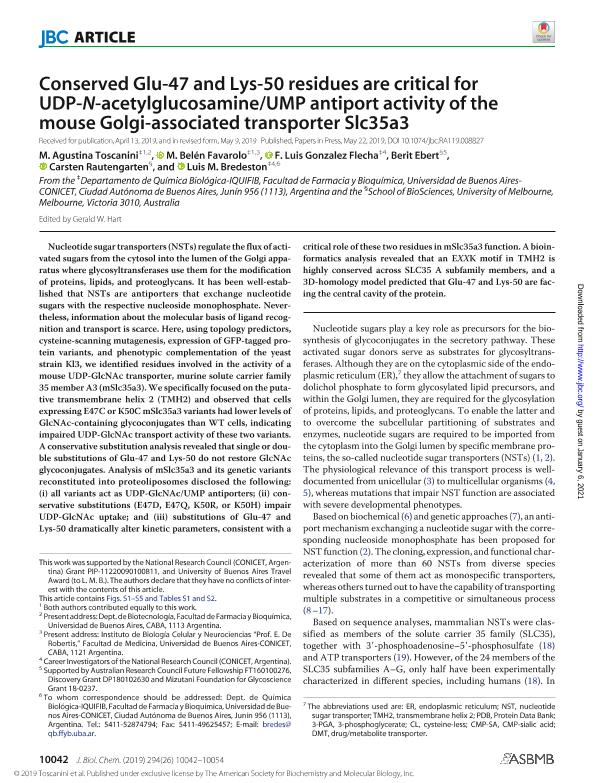Artículo
Conserved Glu-47 and Lys-50 residues are critical for UDP-N-acetylglucosamine/UMP antiport activity of the mouse Golgi-associated transporter Slc35a3
Toscanini, María Agustina ; Favarolo, Maria Belen
; Favarolo, Maria Belen ; Gonzalez Flecha, Francisco Luis
; Gonzalez Flecha, Francisco Luis ; Ebert, Berit; Rautengarten, Carsten; Bredeston, Luis María
; Ebert, Berit; Rautengarten, Carsten; Bredeston, Luis María
 ; Favarolo, Maria Belen
; Favarolo, Maria Belen ; Gonzalez Flecha, Francisco Luis
; Gonzalez Flecha, Francisco Luis ; Ebert, Berit; Rautengarten, Carsten; Bredeston, Luis María
; Ebert, Berit; Rautengarten, Carsten; Bredeston, Luis María
Fecha de publicación:
05/2019
Editorial:
American Society for Biochemistry and Molecular Biology
Revista:
Journal of Biological Chemistry (online)
ISSN:
0021-9258
e-ISSN:
1083-351X
Idioma:
Inglés
Tipo de recurso:
Artículo publicado
Clasificación temática:
Resumen
Nucleotide sugar transporters (NSTs) regulate the flux of activated sugars from the cytosol into the lumen of the Golgi apparatus where glycosyltransferases use them for the modification of proteins, lipids, and proteoglycans. It has been well established that NSTs are antiporters that exchange nucleotide sugars with the respective nucleoside monophosphate. Nevertheless, information about the molecular basis of ligand recognition and transport is scarce. Here, using topology predictors, cysteine-scanning mutagenesis, expression of GFP-tagged protein variants, and phenotypic complementation of the yeast strain Kl3, we identified residues involved in the activity of a mouse UDP-GlcNAc transporter, murine solute carrier family 35 member A3 (mSLC35A3). We specifically focused on the putative transmembrane helix 2 (TMH2) and observed that cells expressing E47C or K50C SLC35A3 variants had lower levels of GlcNAc-containing glycoconjugates than WT cells, indicating impaired UDP-GlcNAc transport activity of these two variants. A conservative substitution analysis revealed that single or double substitutions of Glu-47 and Lys-50 does not restore GlcNAc glycoconjugates. Analysis of mSLC35A3 and its genetic variants reconstituted into proteoliposomes disclosed that i) all variants act as UDP-GlcNAc/UMP antiporters; ii) conservative substitutions (E47D, E47Q, K50R or K50H) impair UDP-GlcNAc uptake; and iii) substitutions of Glu-47 and Lys-50 dramatically alter kinetic parameters, consistent with a critical role of these two residues in mSLC35A3 function. A bioinformatics analysis revealed that a EXXK motif in TMH2 is highly conserved across SLC35 A subfamily members, and a 3D-homology model predicted that Glu-47 and Lys-50 are facing the central cavity of the protein
Palabras clave:
GOLGI
,
UDP-GlcNAc METABOLISM
,
ANTIPORTER
,
CONGENITAL GLYCOSYLATION DISORDER
Archivos asociados
Licencia
Identificadores
Colecciones
Articulos(IQUIFIB)
Articulos de INST.DE QUIMICA Y FISICO-QUIMICA BIOLOGICAS "PROF. ALEJANDRO C. PALADINI"
Articulos de INST.DE QUIMICA Y FISICO-QUIMICA BIOLOGICAS "PROF. ALEJANDRO C. PALADINI"
Articulos(NANOBIOTEC)
Articulos de INSTITUTO DE NANOBIOTECNOLOGIA
Articulos de INSTITUTO DE NANOBIOTECNOLOGIA
Citación
Toscanini, María Agustina; Favarolo, Maria Belen; Gonzalez Flecha, Francisco Luis; Ebert, Berit; Rautengarten, Carsten; et al.; Conserved Glu-47 and Lys-50 residues are critical for UDP-N-acetylglucosamine/UMP antiport activity of the mouse Golgi-associated transporter Slc35a3; American Society for Biochemistry and Molecular Biology; Journal of Biological Chemistry (online); 294; 26; 5-2019; 10042-10054
Compartir
Altmétricas



